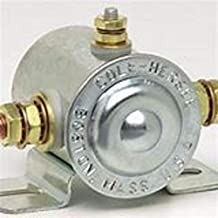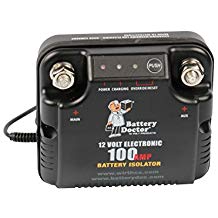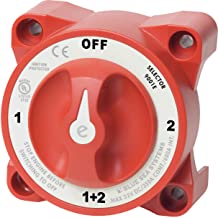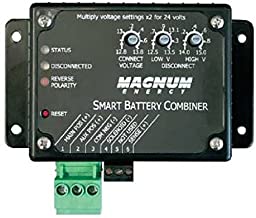This is an old revision of the document!
Table of Contents
Words of Wisdom: “With a isolator you would run the truck early to get a fair amount of the bulk charging done and let the solar finish it off the rest of the day.” – jimindenver1)
Alternator charging
aka Split Charging for our European friends
In a dual-battery system2) some of the alternator output is used to charge the house batteries when the engine is running. When the engine is not running the house battery is electrically isolated from the starter battery to keep from draining it and leaving you stranded. So the devices that handle the isolating/combining duties are called battery isolators. There are several different types.
when alternator charging works well
- when batteries are deeply discharged
- when combined with solar or some other higher-voltage charging source
- when used with battery chemistries like lithium that do not need staged charging.
- when used with a battery-to-battery boosting charger that can produce correct charging voltage
limitations
Alternator charging is generally only practical for the bulk charge stage due to relatively low voltage output and the long time periods required for absorption.3) It is unlikely to get the house battery completely charged unless one is driving significant distances. This can have an impact on battery longevity. If one drives often a combination of the alternator doing bulk charging and a small solar doing the rest is good match.
Vehicles with smart (variable voltage) alternators may not be suitable for charging with normal isolators.4) See below.
See Is Solar Mandatory? for ideas on how to charge primarily by alternator.
effect on alternator
Charging the house batteries from the alternator increases the load on the alternator and can be expected to contribute to somewhat earlier failure. The shortened life may be trivial if alternator charging is done thoughtfully, and may be sudden if done without considering the effects of higher alternator loading. If/when the OEM alternator fails a higher output one can be installed for not much more than it would cost to replace the original.
SternWake reports idling while charging causes a sharp increase in alternator temperature.5) To avoid this, do your alternator charging while driving. This will ensure airflow over the hot alternator.
effect on GDI engines
High-performing engines with Gasoline Direct Injection can experience carbon fouling on the backside of intake valves, which can cause “drivability woes… misfires” and dislodged carbon flakes can cause “turbocharger issues… catalytic converter damage.”6)
Anecdotally the problem appears to be worsened with excessive idling, although this may be a subset of situations where “the engine doesn’t run long enough or hard enough to get hot enough to burn any of the carbon off.”7)
smart alternators
Traditional alternators typically try to hold a set voltage. Smart alternators talk to the vehicle's ECU (compuuter) vary output voltage depending on present conditions. It might unload the alternator during heavy acceleration to reduce parasitic losses, or run the alternator at high voltage just after starting to speed up the recovery of used energy.8)
The use of plain isolators with smart alternators may result in the rapid cycling of the isolator's circuit (with voltage sensing types) or the discharge of the house battery into the starter battery (solendoid type).
DC-DC chargers and/or isolators with an awareness of smart alternators may be required.
isolators
Power from the alternator is shared with the house battery using an isolator (“Split charge relay” / SCR) of some sort. This allows the house battery to charge but does not allow the house battery to pull power from the starter battery.
constant-duty solenoid
 A constant-duty solenoid is an electromechanical device which uses an electromagnet to complete the charging circuit when the engine is running. Solenoids are generally cylindrical. Energizing the solenoid will cause a 0.5A - 1A current drop between the alternator and house battery. Exception:
Latching isolators use latches9) instead of electromagnets to hold the circuit closed, eliminating that vector of power consumption.
A constant-duty solenoid is an electromechanical device which uses an electromagnet to complete the charging circuit when the engine is running. Solenoids are generally cylindrical. Energizing the solenoid will cause a 0.5A - 1A current drop between the alternator and house battery. Exception:
Latching isolators use latches9) instead of electromagnets to hold the circuit closed, eliminating that vector of power consumption.
10). SternWake recommends the Blue Sea 901211) although non-marine units in the $20-$50 range are more common in vans.
Solenoids can be used for self-jumpstarting if the chassis battery has enough juice to engage the solenoid.
voltage-sensing relays
 voltage sensing relays are solenoids with a bit of extra logic to know when to connect/disconnect. The VSR does not get trigger voltage from the fuse panel but rather reads the voltages of one12) or both))dvsr)) batteries to know when to switch on.
voltage sensing relays are solenoids with a bit of extra logic to know when to connect/disconnect. The VSR does not get trigger voltage from the fuse panel but rather reads the voltages of one12) or both))dvsr)) batteries to know when to switch on.
This kind of isolator may have a “combine” override function to enable self-jumpstarting.
- single voltage sensing - this type reads the voltage of only one battery. In the case of an RV it would read the voltage of the starting battery. When it is high enough above resting voltage (ie, being charged by alternator) it connects the starting and house batteries.
[secessus says: “IMO the practical benefit (if any) to charging the starter battery “first” is keeping the load on the alternator reasonable. In practice, the isolator generally connects the two within a few seconds.”]
Examples: Sure Power 1314, BlueSea BatteryLink, Battery Doctor. - dual voltage sensing - this type reads the voltage from both batteries and when either is high enough it connects the batteries. This may or may not be what an RVer wants
Examples: Sure Power 1315, BlueSea SI-ACR, JayCorp Smart Dual Battery 140A Isolator13) - DC-DC isolators (aka b2b isolators) that boost alternator voltage to more appropriate levels for lead chemistries and can do multistage charging. These have their own page.
solid state isolator: diode-based
Note: this type of isolator is no longer common for our uses.
These isolators are electronic devices which use diodes to prevent depletion of the starter battery. Isolators are generally brick-shaped. Diode-based isolators have a 0.5v - 1v drop between the alternator and house battery. This may be desirable if the house battery is a wants lower-voltage charging like LiFePO4. Some solid state isolaters use FETs and diodes in tandem to reduce voltage drop.
Note: solid state relays can't combine batteries for self-jumpstarting.
solid state isolator: FET-based
This type of isolator is similar to the diode-based one above, except that FET components are used instead of diodes, preventing voltage drop.
manual switch
 The simplest and least-featured isolator is a manual switch.
The simplest and least-featured isolator is a manual switch.
A manual battery switch normally has 4 positions: A, B, A+B, and Off. A would be for the starter battery and used during starting. B would be used for house use when one is not driving. A+B could be used to combine both sets for starting or for charging while driving. This kind of setup is prone to user error. A manual switch has no current or voltage losses.
misc
[note from secessus: “not sure what's inside these solid state isolators”]
 The Magnum Energy ME-SBC is notable for some unusual features:
The Magnum Energy ME-SBC is notable for some unusual features:
- configurable connect/disconnect setpoints
- ability to drive a solenoid, which allows for much greater current
Xantrex makes a 15A Digital-Echo Charge isolator.
sizing an isolator
If an isolator is oversized it will cost more for no benefit and will self-consume somewhat more energy to hold the combining circuit closed.14)
If an isolator is undersized (less common) it will not be able to carry enough current, resulting in overheating and/or sudden shutdown.
Most AGM will pull about C/3 (33A for a 100Ah bank) but premium brands may do more. Flooded lead-acid batteries tend to pull less current (C/5, 20A per 100Ah of bank). If your flooded back will only pull ~40A, or your AGM bank 70A then there is little reason to spend more money on a 150-200A isolator.
Lithium in particular has low internal resistance and can pull 1C (100A for an 100Ah bank) or more. Victron posted a video showing it is possible to “smoke” an alternator while charging lithium. Since lithium does not care much about state of charge, there is little reason to go for maximum force lithium charging. Some Li bank owners use DC-DC isolators which limit themselves to a particular output (20A, 60A, 100A, etc).15)
Reasonable charging rates can also be easier on the alternator when charging suddenly stops, whether by completion16) or BMS intervention. Blue Sea makes an alternator field disconnect which shuts down alternator power just before disconnecting the load, but this may be chiefly applicable to marine alternators. Others have discussed installing a small lead-acid battery parallel to the Li bank; in theory this could soften the blow from Li leaving the circuit. Other sources suggest the presence of the starter battery would be sufficient.17)
flooded lead-acid
FLA batteries can accept up to C/5 in Bulk stage.
Example: a 200Ah FLA battery bank will pull up to 40A18) in Bulk charging. An isolator rated for constant duty at 40A19) would be sufficient.20)
AGM lead-acid
Consumer-grade AGM batteries typically will accept C/5 - C/3.
Example: a 200Ah AGM bank will pull up to 67A in Bulk. A 75A isolator21) would be sufficient.
Note: high-end AGM like Lifeline, Odyssey, Rolls, etc, can pull massive current when charging. 200A+ would be possible for the example bank and could shorten the life of a stock alternator.
lithium
Lithium also has the ability to accept massive amounts of charging. It will do so across the entire charging range, as lithium does not have an Absorption phase the way lead-acid does.
Example: 200Ah of lithium could easily accept 200Ah+. There are mitigating factors, however.
- Because lithium can use about 80% of it's capacity instead of 50% for lead-acid, 120Ah of lithium is a common replacement for 200Ah lead-acid banks. So the lithium bank would “only” draw 120A instead of 200A.
- drop-in lithium banks like Battleborn have a battery monitoring system (bms) to shut down charging if current exceeds specs.
sudden disconnection
Sudden disconnection of a large load22) when the alternator is running can damage the alternator and any operating chassis electronics. Sudden disconnection can occur when:
- an isolator shuts off due to current beyond it's rating
- a BMS shuts off lithium charging. This can include overvoltage, overcurrent, temperature extremes, etc.
gotchas
Alternator charging may bring some battery chemistries (like lithium) to unsuitably high voltages. A high voltage disconnect can restrict alternator charging to lower voltages. DC-DC chargers can also regulate voltage provided to the house battery.
Solar charging while the isolator circuit is closed (ie, batteries connected) can pass higher-than-normal voltage to the chassis and starter battery. See notes on HVD and DC-DC charging above.
Voltage-sensing regulators can be triggered or "held closed" by voltage from the solar-charged side in some scenarios. Address with HVD as above if desired.
Idling the engine to charge house batteries can seriously overheat the alternator. It is usually cooled by wind from the vehicle's forward motion; a fan may help cool the alternator.
In early morning when house battery voltage is lowest, a plain solenoid may unintentionally allow depleted batteries to pull down the starter battery. Workarounds: use a VSR, or start the vehicle immediately after inserting the key23).
Solar charging while the isolator circuit is closed may "stall" at alternator voltage.
wiring
2 gauge copper wire connecting the coach and house is recommended for most alternator charging installs. SternWake recommends attaching at the alternator rather than the battery.24)
Note that you will only have to run the POS+ leg of wire to the house battery as the chassis ground is the other leg.
alternator hacks
There are ways to get the alternator to pump out more power:
- a higher-output alternator will put out more power
- a different voltage regulator for older vehicles, as demonstrated by SternWake, increases the voltage available for charging but also increases the coach voltage.
- a Sterling “fake load” regulator will cause the alternator to put out more amps and then will DC-DC convert the voltage up to correct charging range.25). This is the opposite direction of how MPPT charging works. Also see b2b chargers.
using the coach battery only
A simple possible approach would be to replace the starter battery with a marine or AGM battery.26)
further reading
- Split Charging Guide - a British page. Note the following differences in terminology from American English:
- “split charging” == alternator charging
- “leisure battery” == house battery

